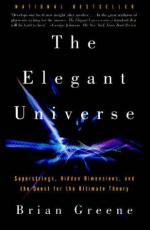
|
| Name: _________________________ | Period: ___________________ |
This test consists of 15 multiple choice questions and 5 short answer questions.
Multiple Choice Questions
1. What is the Planck mass?
(a) The typical mass created by quantum foam over one nano-second.
(b) The typical energy of a quark.
(c) The average mass gained by a string when it changes to a higher-frequency pattern.
(d) The typical mass of a vibrating string.
2. What is the result when a particle of matter and a particle of antimatter are brought into contact?
(a) A theoretically unlimited amount of energy is released.
(b) Energy is released and both particles are destroyed.
(c) A black hole is formed.
(d) A strange quark is formed.
3. What is the photoelectric effect?
(a) Electrons and photons only interact if they have the same frequency.
(b) Electrons follow quantum paths made by photons.
(c) Photons can spontaneously decay into electrons in powerful magnetic fields.
(d) When light shines on metals, the metals emit electrons.
4. What discovery about string theory triggered the "superstring revolution"?
(a) It was found to encompass the four fundamental forces of matter.
(b) Its approximate equations were solved for the first time.
(c) Einstein announced that it exactly matched his formulas for general relativity.
(d) It was experimentally confirmed at Fermilab in the US.
5. Which of the follow is true of objects with which string theory is concerned?
(a) It concerns one-dimensional strings and nothing else.
(b) They are all really Calabi-Yau shapes.
(c) They include strings and other objects as well.
(d) The objects are purely imaginary.
6. Which of the following best describes a fermion?
(a) A particle of matter.
(b) The super-partner of a proton.
(c) The supersymmetric version of a proton.
(d) A messenger particle for a force.
7. When the distance between two objects is doubled, what happens to the strength of the gravitational pull between them?
(a) It diminishes to one-fourth its original value.
(b) It is unchanged.
(c) It diminishes to one-half its original value.
(d) It quadruples.
8. What discovery was made that incorporated gravitational force into quantum mechanics via string theory?
(a) At extremely small scales, gravity is fused with the strong force.
(b) Gravity was found to be supersymmetric.
(c) Gravity could be made symmetric only if the graviton is a string.
(d) A vibrational pattern with the properties of the graviton was discovered.
9. According to Einstein's theory of general relativity, if two objects have a gravitational pull on one another, and one changes its mass or distance from the other, how quickly does the effect of this change travel to the other object?
(a) Near the speed of light, faster for lighter objects.
(b) Instantaneously.
(c) Near the speed of light, faster for more massive objects.
(d) At exactly the speed of light.
10. What are the vibrational patterns that a string can exhibit called?
(a) Chords.
(b) Resonances.
(c) Harmonics.
(d) Notes.
11. Why are the fluctuations that quantum physics predicts not observable in everyday life?
(a) The fluctuations only occur in deep space.
(b) The human brain filters them out.
(c) Most fluctuations are canceled out by electromagnetic waves, like light.
(d) On large scales, the effects cancel each other out.
12. What rule did Max Planck discover the electromagnetic waves bounded in a container, such as an oven, must follow?
(a) There must be an even number of peaks and troughs.
(b) The frequencies of the waves must all be the same.
(c) The energies of all waves inside the over must cancel out to zero.
(d) They must have a whole number of peaks and troughs that fit perfectly inside the container.
13. According to special relativity, which of the following is true about the passage of time for an observer moving near the speed of light?
(a) The passage of time could not be predicted.
(b) Time would pass very quickly compared to an observer at rest.
(c) No time would pass at all.
(d) Time would pass slowly compared to an observer at rest.
14. According to Newton's law of gravity, the strength of the pull between two objects depends on what factors?
(a) Their masses and potential energies.
(b) The distance between them and their average atomic numbers.
(c) Their densities and the strength of the gravitational field they occupy.
(d) Their masses and the distance between them.
15. Which of the following is not one of the four fundamental forces of the universe?
(a) The nuclear-weak force.
(b) The photoelectric force.
(c) The electromagnetic force.
(d) Gravity.
Short Answer Questions
1. What characteristic of the string determines the properties of the particle it represents?
2. How can black holes be detected?
3. What is different about a particle of antimatter, compared to its normal counterpart?
4. Which of the following is true regarding the mass and spin of a pair of superpartners?
5. According to general relativity, the change that an object causes in the fabric of space-time depends directly on _____.
|
This section contains 835 words (approx. 3 pages at 300 words per page) |

|




